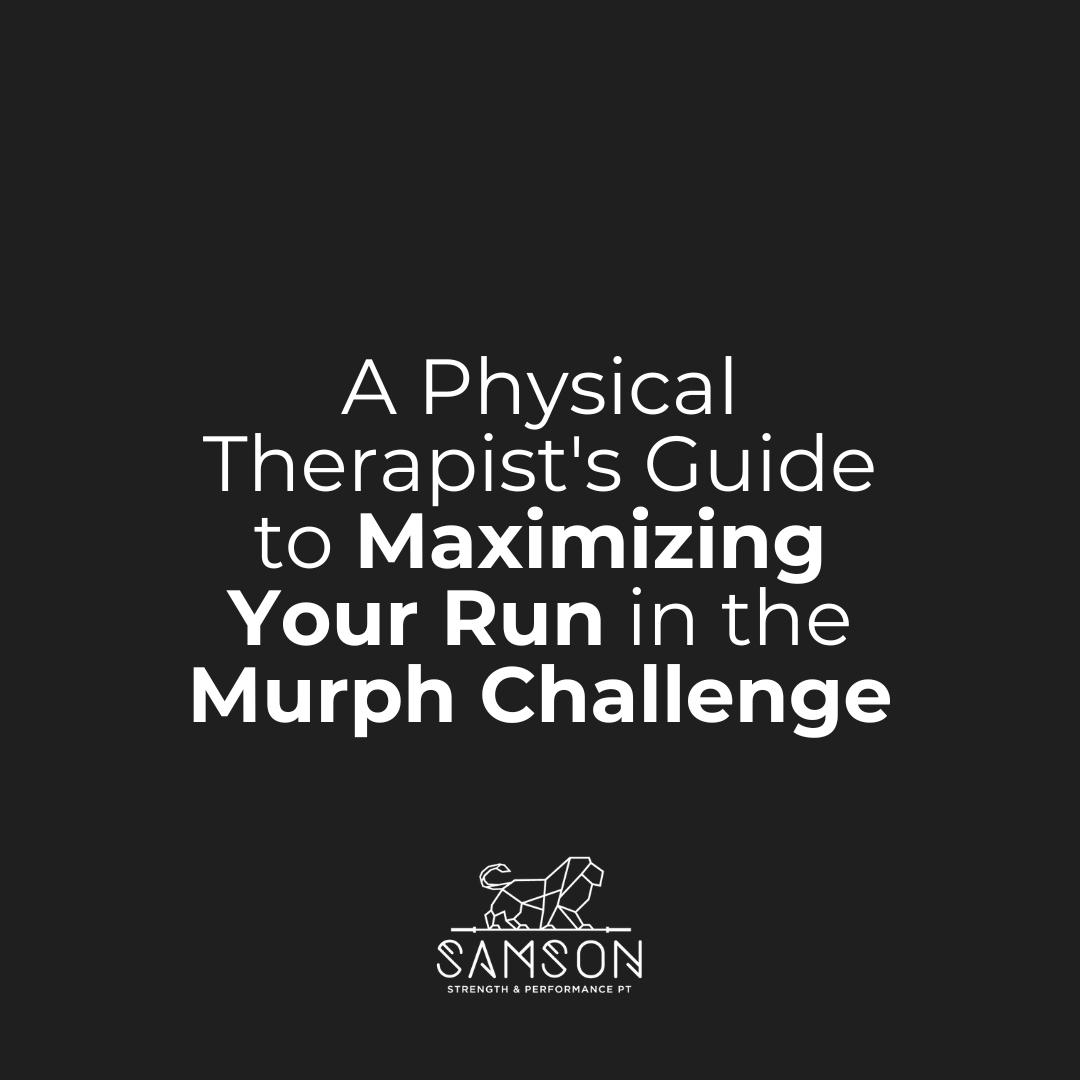A Physical Therapist's Guide to Maximizing Your Run in the Murph Challenge
Embarking on the Murph Challenge is an endeavor that tests both physical prowess and mental fortitude. For those unfamiliar, the Murph Challenge is a workout named after Navy Lieutenant Michael P. Murphy, who lost his life in Afghanistan in 2005. It consists of a one-mile run, 100 pull-ups, 200 push-ups, 300 air squats, followed by another one-mile run – all performed while wearing a weighted vest.
While each aspect of the Murph Challenge presents its own struggles, the runs are often underestimated - especially if you are not used to running. In this blog post, I'll share some insights and strategies to optimize your performance on the run portion of the Murph.
Preparing Physically:
Endurance Training: Endurance forms the foundation of success in the Murph run. Begin by gradually increasing your running volume with a focus on building aerobic capacity through longer, steady-state (Zone 2 heart rate) runs. As your fitness improves, incorporate interval training and tempo runs to enhance both aerobic and anaerobic thresholds. Remember to listen to your body and avoid overtraining, as injury setbacks can derail your progress.
Strength Training: While it typically takes 8-12 weeks to demonstrate true strength gains, it’s never too late to be working on improving the loading capacity of the muscles in your feet and legs. Be sure to incorporate exercises that target your gastroc and soleus muscles, your hip abductors, and your foot intrinsics. Accessory exercises targeted to strengthen these muscle groups often get neglected, but they are crucial to improve your efficiency while running!
Also, be sure to meet yourself where you are - if you have never run in a weighted vest, don’t feel obligated to wear one during the workout simply because others are doing so. If you do elect to wear a vest, give your body an opportunity to adapt to the extra load by doing some training runs in the vest in the weeks leading up to the big day.
Core Stability: A strong, stable core is the linchpin of efficient running mechanics and is necessary to produce force during push off while running. Be sure to incorporate exercises into your weekly routine that target the deep core muscles, including: psoas marches, farmer carries, and pallof presses. By fortifying your core, you'll improve your lower back stability and minimize energy loss, allowing you to maintain an efficient running stride throughout the workout.
Optimizing Performance on the Run:
Dynamic Warm Up: Prior to any run, but especially on the day of Murph, be sure to warm up with some dynamic movements that target key muscle groups involved in running, including the calves, hamstrings, quadriceps, and hip flexors. If you are unsure of what your warm up should look like, follow this link for some examples of the dynamic stretches we like to implement before your runs.
Pacing Strategy: Approach the runs with a strategic mindset. Resist the temptation to start too fast, as an overly aggressive pace can lead to premature fatigue. Instead, aim for a steady, sustainable pace that allows you to conserve energy for the duration of the workout. Focus on maintaining a consistent rhythm and cadence throughout the run. Current running literature suggests that if you shoot to maintain a step rate of around 170 steps per minute, you will decrease the impact forces your body feels from the ground, which will be much needed if you elect to wear a weighted vest! (Luedke, 2016)
Breathing Techniques: Conscious breathing can enhance your running efficiency and help manage fatigue during the workout. Practice diaphragmatic breathing: inhaling deeply through your nose and exhaling fully through your mouth. Experiment with different breathing patterns to find what works best for you, whether it's a 2:2 rhythm (inhale for two steps, exhale for two steps) or a 3:2 rhythm. Again, make an effort to practice these activities prior to the day of the workout to give yourself a higher likelihood of success!
Mental Preparation: Running in the midst of a grueling workout like Murph requires mental toughness and resilience. Mentally rehearse the run segments beforehand, visualizing yourself moving effortlessly and staying focused on your form. Break the run into smaller milestones, focusing on reaching each checkpoint one step at a time. Embrace the discomfort as a natural part of the challenge, knowing that you have the strength and determination to overcome it. We are built to do hard things!
In the crucible of the Murph Challenge, the runs serve as both physical challenges and mental battlegrounds. By implementing targeted training strategies, pacing judiciously, and prioritizing a thorough pre-run warm up, you can optimize your performance on the run and elevate your overall experience. Remember, success in the Murph Challenge isn't just about completing the workout – it's about honoring the sacrifice of Lt. Michael P. Murphy, embodying the spirit of resilience, and pushing beyond your perceived limits.
So lace up your shoes, strap on that weighted vest (if you have been training to do so), and embrace the challenge of the run (and workout). With preparation, perseverance, and a dose of grit, you'll conquer the miles and emerge stronger on the other side.
Reference:
Luedke LE, Heiderscheit BC, Williams DS, Rauh MJ. Influence of Step Rate on Shin Injury and Anterior Knee Pain in High School Runners. Medicine and Science in Sports and Exercise. 2016 Jul;48(7):1244-1250. DOI: 10.1249/mss.0000000000000890. PMID: 26818150.
Looking for help with programming for improving your performance?
At Samson Strength and Performance PT, we can help you not only improve your performance in Running, but also help you stay injury free. Request a free call by clicking the link below. We’d love to help you.
Next on your reading list:

